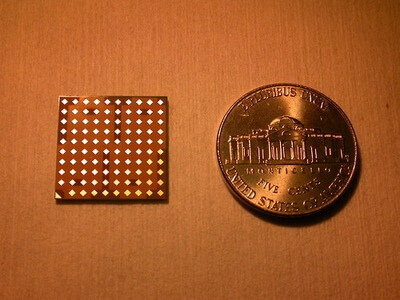A milestone in the construction of a miniaturized integrated array of receivers-transmitters that includes all the components for communication in a millimeter-wide wave

Scientists at IBM have achieved a milestone in building a miniaturized integrated array of receivers-transmitters that includes all the components for millimeter-wide wave communication, required both for fast data traffic and for high-resolution radar imaging applications. The integrated circuit presented by IBM deals with bottlenecks typical of data communication, and allows a radar imaging system to be miniaturized to the dimensions of a typical laptop.
Integrating advanced work capabilities in radio frequencies is a central engine for the growth of the capabilities of mobile devices and for the sophistication of applications that operate on them. A bandwidth of one millimeter makes it possible to support wireless communication at gigabit per second rates, and significantly expands the possibilities of working in a mobile environment, establishing cellular communication infrastructures in small communication cells, and deploying improved communication networks in data processing centers.
The frequency range of the new integrated circuits is suitable for high-resolution radar and radar imaging applications, thanks to the short wavelength, the relatively low decay under normal atmospheric conditions, and the ability to penetrate piles of rubble and debris. IBM's new technology makes it possible to miniaturize radar systems, and give pilots a new tool capable of penetrating through a screen of fog, dust and other obstacles that interfere with vision.
The new transmitter-receiver built at IBM presents the highest level of component integration achieved so far in silicon-based solutions for millimeter frequency applications. Its introduction is considered an essential step on the way to building future systems that will offer a flexible midrange range, small volume, and low price.
The new transmitter-receiver operates in the 90-94 GHz frequency range, and is implemented as a unit that combines four circuits and 64 dual-polarized antennas. Packing such packages side by side on one printed circuit board allows building an array of components while maintaining a constant spacing between the antenna components. The ability to create the radar beam is born thanks to the hundreds of antenna units, which allow communication and imaging applications using radar to cover a range estimated in kilometers.
Each of the four circuit units incorporates 32 receiver components and 16 transmission components that produce a double output - in order to support 16 antennas. The system supports multiple modes of activity, including simultaneous reception of horizontal or vertical polarization. The production process is based on IBM's advanced silicon germanium technology for building semiconductors, which allows the circuit to include and integrate frequency synthesis and frequency conversion, as well as digital control.
The entire integrated solution, including antennas, case, receiver and transmitter units, is compressed to dimensions smaller than those of a single shekel coin.
Operators of mobile communication networks have already begun to try to ease network loads by using communication in the E-Band frequency range, which is allocated by the FCC for point-to-point communication applications. The frequency range 71-76 GHz, 81-86 GHz and 92-95 GHz enables wireless data transfer at extremely fast rates. The atmospheric decay of radio signals in these frequency ranges is relatively low, making them particularly suitable for long-range communication tasks.
E-band solutions that were available until now required a large number of chips, and mechanically tuned antennas. IBM's new chip array makes it possible to control the transmission beam using only electronics, and offers bandwidth that supports communication at gigabit per second rates, for distances of kilometers.
Millimeter waves operate in the electromagnetic spectrum range between 30-300 gigahertz - ten times to a hundred times the frequencies currently used for cellular communication and Wi-Fi applications. Frequencies 90-94 are particularly suitable for radar imaging, short or long term, with high resolution. Weather disturbances, debris from avalanches and other obstacles put pilots trying to see through an unclear picture. The polarization support of two antennas, while minimally enlarging the entire device, offers an additional advantage in navigating through fog or rainstorms.
IBM unveiled the new system at the IEEE conference for integrated circuits in the world of radio, held this week in Seattle.
